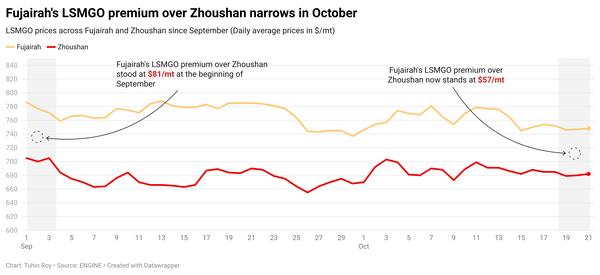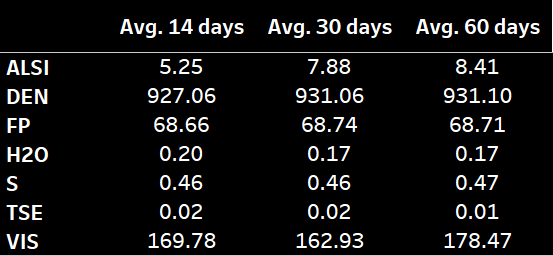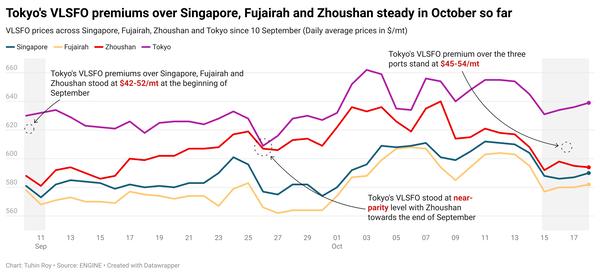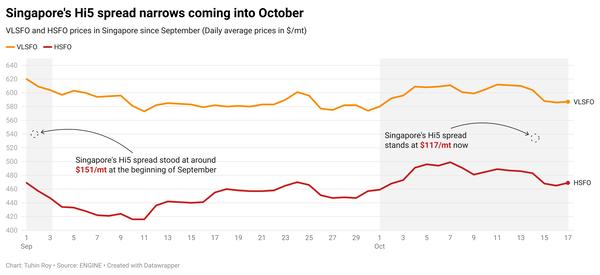East of Suez Market Update 18 Oct 2024
Most prices in East of Suez ports have moved up, and LSMGO availability remains good across most Japanese ports.
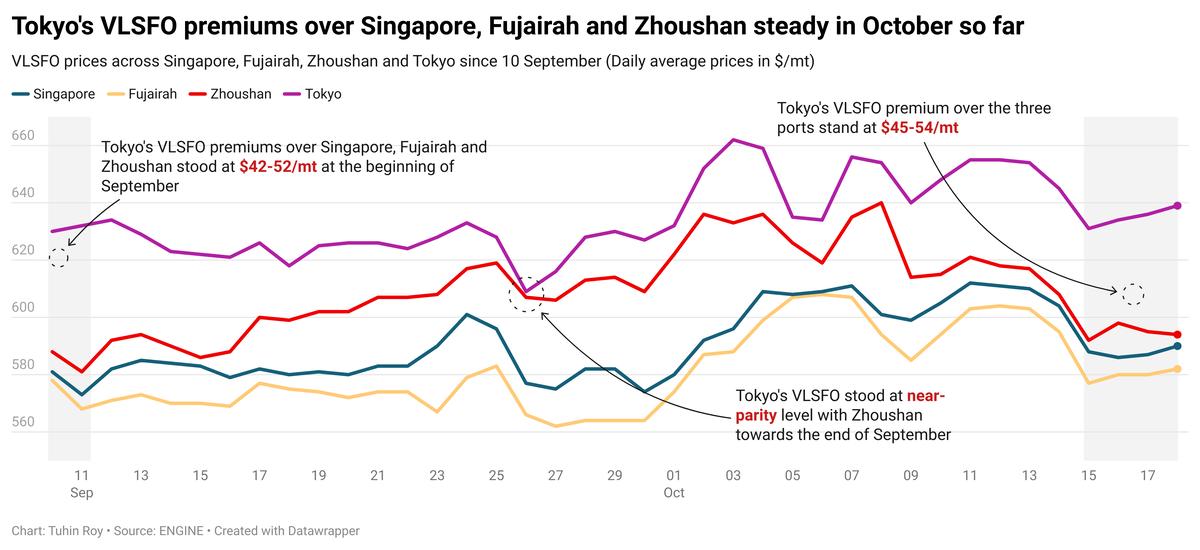
Changes on the day to 17.00 SGT (09.00 GMT) today:
- VLSFO prices up in Fujairah ($4/mt) and Singapore ($3/mt), and down in Zhoushan ($6/mt)
- LSMGO prices up in Zhoushan ($4/mt), Fujairah ($3/mt) and Singapore ($1/mt)
- HSFO prices up in Singapore and Zhoushan ($1/mt), and down in Fujairah ($1/mt)
Zhoushan’s VLSFO price has dropped by $6/mt in the past day, while VLSFO prices in Singapore and Fujairah have remained mostly stable. The VLSFO price in Zhoushan was pushed down by two lower-priced VLSFO stems, which were fixed within a narrow range of $3/mt. Despite the price drop, Zhoushan's VLSFO stands at a premium of $9/mt to Fujairah's and is nearly on par with Singapore's.
VLSFO and LSMGO supplies remain normal in Zhoushan as demand has been low. Some suppliers have extended delivery lead times for both grades from 3-5 days last week to 4-7 days now. Meanwhile, HSFO supply in Zhoushan has tightened due to stock shortages among some suppliers, increasing lead times from 3-5 days to 7-10 days.
In Japan, Tokyo continues to price its VLSFO at higher levels than the three major Asian bunker ports – Singapore, Fujairah, and Zhoushan – with premiums of $54/mt, $49/mt, and $45/mt, respectively.
Prompt VLSFO supply remains tight at most Japanese ports. HSFO supply is mostly good across Japan, but limited for prompt supply in Oita. LSMGO supply remains strong at key ports including Tokyo, Chiba, Yokohama, Kawasaki, Osaka, Kobe, Sakai, Nagoya, Yokkaichi, Mizushima, and Oita. However, supply in Oita is still constrained due to the closure of Idemitsu Kosan’s Yamaguchi refinery in March.
Brent
The front-month ICE Brent contract has gained $0.07/bbl on the day, to trade at $74.41/bbl at 17.00 SGT (09.00 GMT).
Upward pressure:
Brent crude’s price has inched up as supply concerns emerged amid escalations in the Middle East.
Israel has ramped up air assaults on southern Lebanon this week, according to the Israeli Defense Forces (IDF). “The IDF will continue to operate to eliminate the threats of Hezbollah,” it said on social media platform X (formerly Twitter).
The IDF has also reportedly eliminated Iran-aligned Hamas armed group’s prominent leader Yahya Sinwar, it said. This comes at a time when reports indicate that Israel has prepared plans for a potential strike on Iran. “There have been reports that Israel will launch its attack [on Iran] ahead of the US Presidential election,” Price Future Group’s senior market analyst Phil Flynn remarked.
Brent’s price also gained after the US Energy Information Administration (EIA) reported a decline in US crude stocks. Commercial crude oil inventories in the US dropped by 2.19 million bbls to touch 421 million bbls on 11 October, according to data from EIA.
A drop in US crude stocks indicates growth in oil demand, which can put upward pressure on Brent’s price. “Crude oil prices ended higher… as US oil inventories fell more than anticipated while Middle East tensions linger,” two analysts from ING Bank said.
Downward pressure:
Oil demand growth concerns from China have continued to cap Brent’s price gains.
Chinese crude oil imports declined in the previous month, to touch 11.07 million b/d, down from 11.56 million b/d imported in August.
The drop in crude imports has indicated a slowdown in oil demand growth in the world’s second-largest crude oil-consuming nation, according to market analysts. “Concerns over China demand continue to weigh [on oil prices],” analysts from Saxo Bank said.
By Tuhin Roy and Aparupa Mazumder
Please get in touch with comments or additional info to news@engine.online

Contact our Experts
With 50+ traders in 12 offices around the world, our team is available 24/7 to support you in your energy procurement needs.

